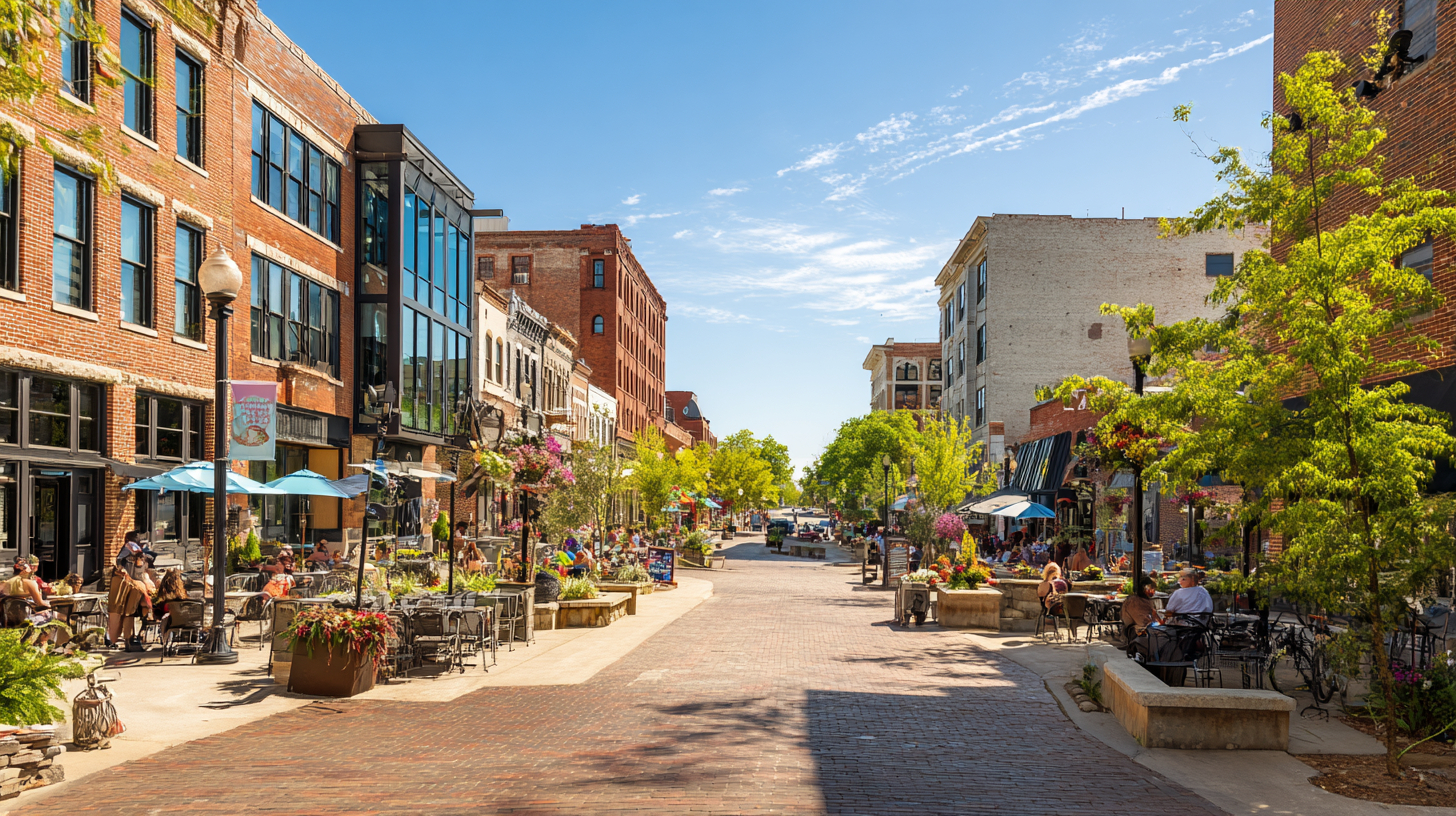Columbia, Missouri sits right in the middle of the state and, in many ways, in the middle of everything. You can slide onto I-70 and hit either Kansas City or St. Louis in two hours, yet the city still feels tucked away from big-metro noise. Estimates from the Boone County assessor put the 2025 population at about 128,000, up a modest 1.4% from last year. New-construction permits cooled in late 2024, so resale homes make up most listings right now. Median sale price hovers near $305,000, roughly 5% higher than twelve months ago. Are people still moving in? Yes, though the pace has slowed since the remote-work rush of 2021–22. That’s the stage. Let’s talk about the real ups and the real downs.
Why You Might Stay a While
You know those towns that brag about “big-city amenities with a small-town feel”? Columbia is one that can actually cash that check.
- People are approachable
Neighbors wave. Cashiers chat. The college crowd keeps things curious and, well, caffeinated. You’ll hear debates about everything from new bike lanes to the best brisket in town, and most of them stay civil. - Culture shows up when you least expect it
One week you’re at a backyard bluegrass jam. The next, you’re standing in a downtown alley watching a muralist paint a four-story wall. Local radio pushes indie bands that later land on national tours. The scene never feels staged—more like it just bubbles up. - Green is everywhere
The Katy Trail clips the south edge of the city, linking riders to 237 miles of river-valley scenery. Rock Bridge Memorial State Park gives you caves, boardwalks, and enough limestone bluffs to feel like you’re hours from civilization. Even neighborhood parks feel oversized, some stitched straight into new subdivisions so the tree line stays unbroken. - Education pulls its weight
Three colleges—University of Missouri, Columbia College, Stephens College—anchor the city. That means constant guest lectures, research gigs, sports events, and far more public-library programming than most towns this size can afford. Public schools feed off that energy. The district now offers a hands-on aerospace engineering track (yes, for high-schoolers) along with dual-credit art history courses. - Healthcare punch above its weight class
Boone Hospital and MU Health consistently score national rankings. For you, that translates to shorter wait times for specialists, experimental clinical trials close to home, and a downtown where white coats are as common as Tiger hoodies on game day. - Job market that doesn’t ignore non-degree talent
Tech start-ups share co-working space with ag-research firms. Construction firms chase those new mixed-use developments popping up around Stadium Boulevard. If you want part-time remote work, fiber internet blankets nearly every subdivision inside city limits. - Commute math actually works
A “long drive” means fifteen minutes from the northwest corner to the university quad. Outside rush hour, you can cross town before the second song on your playlist ends. Pretty easy on the gas card. - Festivals that refuse to phone it in
True/False Film Fest, Roots N Blues, the craft-beer Winter Session—all locally grown, all volunteer-heavy, all worth penciling into your calendar months ahead.
You’ll notice something missing from that list: pretense. Columbia rarely gets carried away with itself. The café barista might be a PhD candidate, yet still remembers your order. Coaches double as middle-school teachers. That blend of ambition and approachability is hard to fake.
Where the Shine Rubs Off
Every town has blind spots. Columbia owns a few you should probably study before forwarding that change-of-address form.
- Housing sticker shock, especially close to campus
A 3-bed, 2-bath bungalow inside the prized Old Southwest district now cracks $400,000—twice what it commanded seven years ago. Investors turned many older homes into rental portfolios during the remote-work boom, so buyers chase fewer listings. If you want acreage, push north or east of Highway 63, but be ready for longer well-and-septic conversations and fewer city services. - Property-tax curveball
Missouri keeps income taxes moderate, yet Boone County assessments spiked in 2023 and again in 2024. Someone who bought at $250k five years ago might be contesting a new assessment at $340k. Budget an extra escrow cushion. - Transit gaps are real
The city bus grid serves the university core nicely but fades the farther you drive toward Battle High School or Thornbrook. Night routes thin out after 7 p.m. If you dream of a car-free existence, you’ll work harder here than in Denver or Madison. Rideshares exist, though surge pricing on game days can feel rude. - Football weekends hijack traffic
Faurot Field holds roughly 62,000 fans. When Saturday kickoff hits, Providence and Stadium become long lines of brake lights. Grocery runs feel cursed. Some locals plan entire fall calendars around away games just to dodge it. - Weather rarely picks one season and sticks to it
July drapes a heavy blanket of humidity across town. Mid-January might be mild at lunch and a sheet of freezing drizzle by dinner. Spring thunderstorms crack the sky open with little notice. If you crave predictable bluebird days, Columbia will test that craving. - Wages lag compared with cost of living growth
The average professional salary sits near $58k, four grand below the national mean. Meanwhile, utilities climbed 14% since 2022, and the price per square foot for new builds keeps inching north. Dual-income households navigate fine; single-income buyers sometimes stretch thin. - Entertainment sweet spot favors 20-somethings
Bars and house shows hum. That’s great until you realize comedy clubs close early and fine-dining choices still fit on one hand. You can find jazz, salsa, or old-school country, but you’ll look harder on a Tuesday night in February. - Growth pains echo in city politics
Zoning meetings run long, tempers flare, and everybody seems to own a yard sign with bold fonts. Nothing new for a university town, yet plan for delayed approvals on remodel permits and the occasional ban on short-term rentals that pops up, then stalls, then pops up again.
Bottom line: Columbia gives more than it takes—unless what you want is big-city transit, bottom-barrel housing prices, or cloud-free winters.
Ready to Size Up Columbia?
We covered the sunshine and the shade. You saw how cozy commutes and trail access can sharpen daily life, yet rising assessments and stop-and-go traffic on game days might dull that edge. No place scores a perfect ten, but if you crave an educated buzz, quick access to wild green space, and a market that still rewards smart offers, Columbia deserves a walk-through. Next step? Dig into neighborhoods, line up a lender who knows local quirks, and schedule a weekend visit when there isn’t a home game. That will tell you more than any article can.
Your Questions, Answered
Q: What sets Columbia apart from other mid-Missouri cities?
A: University energy. Three campuses inject research dollars, concerts, lectures, and constant turnover of new residents, which keeps retail and food scenes fresh.
Q: How healthy is the 2025 job market?
A: Unemployment floats near 3.2%. Healthcare, biotech, and software firms are adding positions, though wages trail coast-to-coast hubs. Remote workers with outside salaries often find themselves ahead.
Q: Which neighborhoods balance affordability and convenience?
A: Buyers on a budget often start in El Chaparral, Vanderveen Crossing, or the east-side Lake of the Woods area. Each one sits within fifteen minutes of downtown but trades larger lots for more basic finishes.
Q: Are public schools really that strong?
A: Overall district test scores land above the state average, especially at Hickman High and Grant Elementary. Magnet programs in STEM and performing arts draw students from surrounding counties.
Q: What kind of weather prep makes sense?
A: A four-season wardrobe, a sump pump if your basement is older, and backup phone chargers for spring storm season. Snow tires? Rarely needed, but an ice scraper is non-negotiable.
Q: Any big developments on the horizon?
A: The new Mid-City corridor plan aims to blend retail, loft apartments, and a transit hub along Business Loop 70. Construction is slated to roll out in phases through 2028, so keep eyes on those parcels if early equity plays excite you.
Thinking Columbia might be your spot? Reach out, line up a couple of showings, and test-drive the town yourself.






